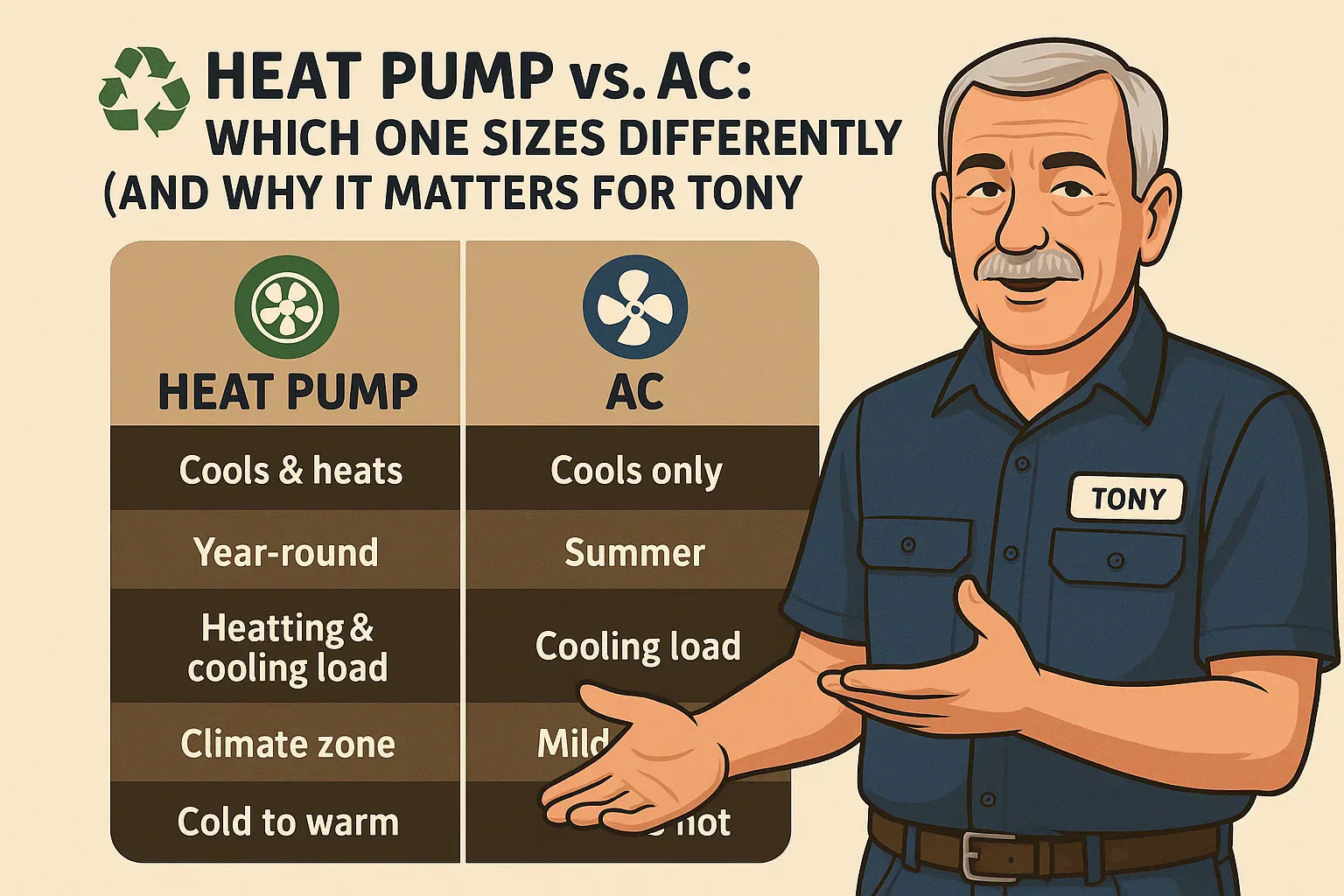Choosing between an air conditioner and a heat pump involves more than just features or price. If Tony wants comfort year-round—and energy efficiency to match—he needs to understand that heat pumps and ACs are sized differently, and it absolutely matters.
This guide will show how HVAC sizing changes based on equipment type, climate zone, and system function—so Tony can make the smartest investment for his home.
⚙️ Understanding the Basics
| System | Function | Season Used | Sizing Focus |
|---|---|---|---|
| Air Conditioner | Cools only | Summer | Cooling load only |
| Heat Pump | Cools and heats | Year-round | Heating and cooling loads |
🔧 Heat pumps reverse refrigerant flow to provide both cooling and heating—so they need to be sized for two seasons, not just one.
🔗 ENERGY STAR – Heat Pump Basics
📏 Why ACs Are Sized for Cooling Load Only
Air conditioners are part of a split system, with:
-
The AC handling cooling
-
A furnace or air handler providing heat
That means:
-
Size the AC to match Manual J cooling load
-
Heating is a separate sizing process
Oversizing an AC = bad humidity control and short cycling
Undersizing an AC = poor cooling performance during peak days
🔗 ENERGY STAR – Proper AC Installation
🔄 Heat Pumps Need to Match Both Loads
Heat pumps carry the dual responsibility of:
-
Cooling in summer (like an AC)
-
Heating in winter (unlike an AC)
That leads to tricky questions:
-
Do you size for peak cooling demand?
-
Or for your region’s heating load?
👉 In colder climates, heating demand often exceeds cooling by 30–60%, forcing trade-offs.
📊 Load Comparison: AC vs Heat Pump in Moderate & Cold Climates

-
In moderate climates, heating and cooling are similar
-
In cold climates, heat pumps may be undersized for heating unless boosted with:
-
Electric heat strips
-
Dual-fuel systems
-
Cold-climate rated equipment
-
🧭 Why Climate Zone Changes the Equation
| Climate Zone | Region | Sizing Focus | Risk |
|---|---|---|---|
| 1–2 | South/Southeast | Cooling | Oversizing heat |
| 3–4 | Southwest/Mid-South | Balanced | Balanced |
| 5–6 | Midwest/Northeast | Heating | Undersized cooling |
| 7–8 | Far North/Mountains | High Heating | Heat pump may struggle |
🧰 Manual J + Manual S: Tony’s Smart Sizing Formula
-
Manual J = precise room-by-room load calculation
-
Manual S = matches HVAC equipment to those loads (for BOTH heating and cooling)
Without these, you risk:
-
A heat pump that cools well but can't heat in January
-
A unit that short-cycles in mild seasons
🔗 CoolCalc Manual J Tool
🔗 ACCA Manual S Standards
🔁 What Happens If You Size a Heat Pump Like an AC?
Tony lives in the Midwest and has a 2,000 sq ft home. His cooling load only needs 30,000 BTUs (2.5 tons), but the heating load is 45,000 BTUs.
If he installs a 2.5-ton heat pump:
-
Summer performance: ✅
-
Winter comfort: ❌ (may need backup strip heat constantly)
🔧 Solution: Upgrade to a 3.5-ton cold-climate model or add a dual-fuel gas furnace.
🌀 Variable-Speed & Cold-Climate Heat Pumps
Modern heat pumps can modulate output to match heating or cooling demand across seasons.
Advantages:
-
Fewer cycles
-
Better humidity control
-
Improved heating in freezing temps
Look for:
-
SEER2 > 16 for cooling efficiency
-
HSPF2 > 8.5 for heating efficiency
🔗 NEEP Cold Climate Heat Pump Product List
❄️ What If the Heat Pump Can’t Meet Heating Load?
-
Add electric strip heat as backup (in milder zones)
-
Consider a dual-fuel system (heat pump + gas furnace)
-
Use zoning or mini-split supplements for hard-to-heat rooms
✅ Tony’s Heat Pump Sizing Checklist
| Step | Task |
|---|---|
| ✅ | Measure home square footage |
| ✅ | Get full Manual J load calc |
| ✅ | Determine both cooling & heating BTU needs |
| ✅ | Compare local climate HDD/CDD data |
| ✅ | Choose variable-speed or dual-fuel if needed |
| ✅ | Ask installer for Manual S match verification |
🧠 Key Takeaways: Heat Pumps vs. AC Sizing
| Feature | Air Conditioner | Heat Pump |
|---|---|---|
| Season Used | Summer only | All year |
| Sizing Focus | Cooling load | Both heating and cooling |
| Risks if Wrong | Humidity & cost | Comfort loss in winter |
| Manual Needed | Manual J | Manual J + Manual S |
| Ideal for Cold? | Yes, with furnace | Yes, with cold-climate model |
📌 Final Thought: One Size Doesn’t Fit All
Tony knows that making the switch from an AC to a heat pump (or installing either for the first time) isn’t just about SEER or brand. It’s about choosing the right size for your entire home and climate—with the heating season just as important as the cooling.
With the right strategy and load calculation, a heat pump can do it all—but only if it’s sized right for both jobs.
In the next topic we will know more about: How to Calculate Square Footage for HVAC Sizing (It’s Not Just About Room Size)







